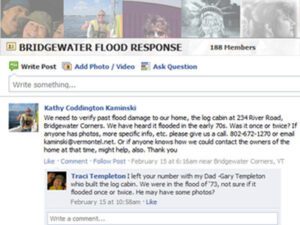For many Vermont communities, the terrible flooding in the wake of Tropical Storm Irene brought home both the importance of a strong community fabric and the value of having multiple channels for communication during a crisis. Bridgewater was one of the e-Vermont towns hit hard by the floods. As town systems became overloaded in the relief effort, local residents used online tools to create a new, informal network to help their neighbors. Bridgewater resident Jeanette Sawyer told their story at e-Vermont’s 2012 regional workshop as part of a panel on social media and emergency management.
I would like to thank e-Vermont for inviting me here today to share the story how a friend, Beth Robinson and I started an impromptu Facebook group, Bridgewater Flood Response. In just 3 weeks nearly 200 members had joined this group that had come together to help disseminate information and connect people that wanted to help with those who needed it. Before long the Bridgewater Grange Hall got stocked with mountains of supplies and food for those that were affected by Irene’s floods and damage. For those people who aren’t convinced, not only does social media work, but it can unite a small community!
Irene damaged or destroyed roads, bridges, businesses, homes and land throughout Bridgewater and left 51 of the 780 residents stranded. Everyone in town pitched in to provide immediate relief, with the town clerk’s office serving as a coordinating center – but still not enough people were being reached with sufficient resources.
Online tools seemed like a good option for bringing in more help. Bridgewater did not have a municipal webpage at that time; volunteers created the Bridgewater Flood Response Facebook page instead. Fifty members joined in less than 24 hours, and soon grew to 200 – a lot in such a small community. The Facebook page listed items needed, items offered, where to go to volunteer, news on road closures and openings, and words of encouragement.
The local Grange Hall became headquarters for coordinating the supplies and volunteer labor that came in through the Facebook page. Just before Irene hit, Comcast had donated an Internet subscription to the Grange through e-Vermont. Members installed a wireless router and their hall became the center for online communications, too.
Other organizations also responded with help. Jeanette recalled the assistance from the Chittenden Volunteer Fire Department:
On Wednesday, Sept 7 we asked them if they had 15 simple items like tooth brushes, size 4/5 diapers and water. About noon on the next day, 15 pickup trucks arrived loaded with fresh produce, eggs, milk, bread, cold meat and supplies. So many supplies in fact, that there was no space left in the large Grange hall so more than half had to be stored in an empty bay of the town garage.
Online tools proved to be a critical conduit for a range of information, Jeanette lists:
. . . unemployment assistance/how to test water and where testing kits were available/ cleanup up techniques and supplies/contacts for various items/ location of flood debris dumpsters/announcements of changes in area activities and flood benefit events/FEMA information/ available pet shelters/lost and found animals/ hours of community services/ Bus transportation schedules/bridge and road status/property tax abatements information/free dinners, lunches and BBQs/clean up help needed and where to meet/automobiles that were offered/clean up help needed and where to meet. We connected work needed to workers needing employment. We also posted flood photographs, videos and related websites.
The efforts at the Grange Hall wound down at the end of October, as the community’s needs shifted from immediate relief to longer term recovery. But interest in social media and online tools remained. Today the town offices are working with e-Vermont partner the Snelling Center for Government to create an official town website. The plan is to include a widget for the Bridgewater Facebook Group once it is launched.

